The Animals in the Amazing Doñana National Park
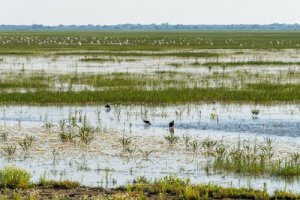

Written and verified by the lawyer Francisco María García
Doñana National Park is a huge protected natural area of beauty in Andalusia, Spain, covering more than 116,000 hectares.
Currently, it’s considered one of the most important natural reserves in Europe. This is due to the diverse flora and fauna that is spread throughout the park, including numerous species in danger of extinction. In this article, we invite you to discover its fauna and just what makes this place so special and important for environmental conservation in Europe.
Ecosystems and climate in Doñana Natural Park
There are three main ecosystems among the enchanting landscapes of Doñana: the Mediterranean scrub, with sandy soils and some floodplains, the marsh and the pine forests.
The Mediterranean climate is the predominant one. It’s characterized by dry summers and relatively wet winters. However, the rainy seasons are mainly in the spring and autumn.
The park’s temperatures are mild throughout the year, averaging 17 C. In the summer, the maximum temperatures can reach 85 degrees Fahrenheit, while the minimum temperatures in winter are rarely below 45 degrees.
Birds: the main protagonists of Doñana’s fauna
The fauna in Doñana’s National Park is mainly characterized by the great biodiversity in the bird population. In fact, there are more than 360 species of birds that live permanently or transiently in the park. Among them, about 125 species reproduce habitually in their ecosystems.
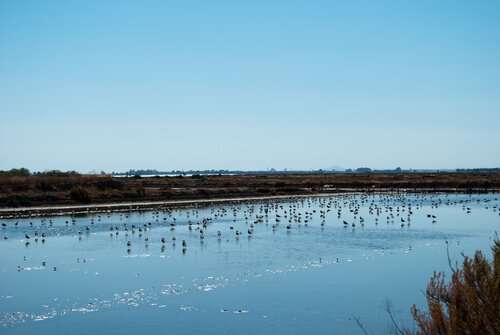
Also, Doñana is a key location for birds that make the migratory journey between Africa and Europe. Additionally, it’s the cradle of preservation for several native Spanish and European species that are currently facing extinction.
Some bird species in Doñana
Among the wide variety of species that we can find in Doñana National Park, we’ll mention the following:
- Mallards (Frieze, Royal, and Wigeon)
- Starling (Black and Pinto)
- Flamingos
- Gray Heron
- Swallow
- Sparrow (Common, Miller and Moruno)
- Owl (Common and Country)
- Kingfisher
- Royal Duck
- Mockingbird
- Anser (Common and Country)
- Small owl
- Vultures (Fawn and Black)
- Raven
- Quail
- Eaglets (Ash, Marsh and Pale)
- Lark
- And, finally, eagles (Imperial, Causeway, Short-toed and Bonelli)
Other typical animals in Doñana National Park
Additionally, Doñana National Park has cataloged more than 35 mammal species, 20 freshwater fish, 10 amphibian species and about 13 reptiles. Below, we have listed some of the most symbolic species in the park.
Mammals
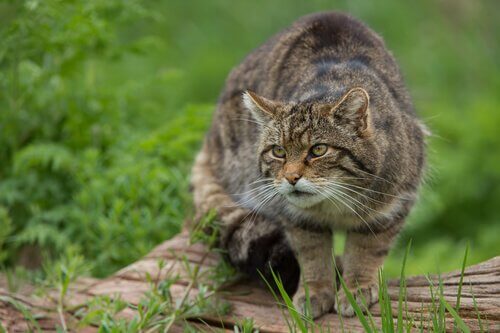
- Iberian lynx
- Wildcat
- Boars
- Horses
- Cows
- European hedgehog
- Deer
- Field rabbit
- And, finally, bats (Common, Cave, Buzzard, and Big Horseshoe)
Reptiles and amphibians

- Snakes
- Turtles
- Common chameleon
- European Galapagos
- Frogs
- Toads
- Lizards

Fish
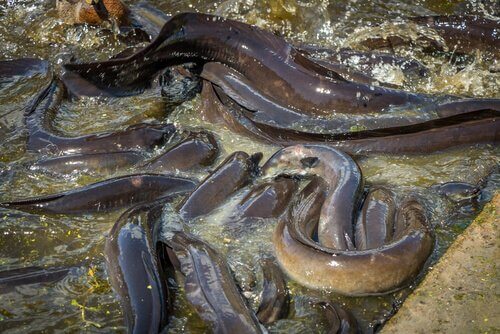
- Eels (native species)
- Carp, Mosquitofish, and Pike (invasive species)
Species in Doñana facing extinction
While the reserve is home to many species that are vulnerable or endangered, there are two animals that are the most threatened. The species in greatest danger of extinction in Doñana National Park are the Iberian lynx and the imperial eagle.
Iberian lynx
Currently, experts consider the Iberian lynx the most threatened feline on the entire planet. The only remaining members of the species live in Doñana, Sierra de Andujar National Park and Cardeña National Park, in Spain.
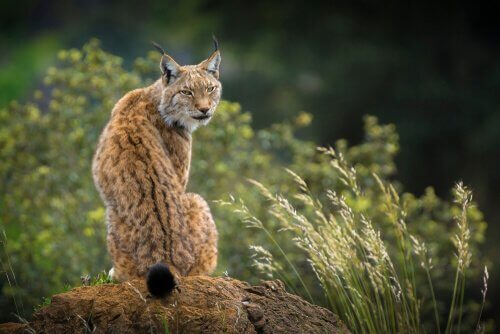
The Sierra de la Malcata Natural Reserve in Portugal is trying to recover this feline’s population.
There is a breeding center in Doñana that is carrying out a breeding program for Iberian lynxes in captivity. There were 11 lynxes born in captivity, and the center also monitors 30 other lynxes that live in the park.
Imperial eagle
The imperial eagle’s situation is just as alarming as that of the Iberian lynx. Similarly, it is one of the most endangered birds in Europe. Currently, there are only 10 pairs of this species in Doñana National Park and this ecosystem is one of their few remaining refuges.

Doñana National Park is a huge protected natural area of beauty in Andalusia, Spain, covering more than 116,000 hectares.
Currently, it’s considered one of the most important natural reserves in Europe. This is due to the diverse flora and fauna that is spread throughout the park, including numerous species in danger of extinction. In this article, we invite you to discover its fauna and just what makes this place so special and important for environmental conservation in Europe.
Ecosystems and climate in Doñana Natural Park
There are three main ecosystems among the enchanting landscapes of Doñana: the Mediterranean scrub, with sandy soils and some floodplains, the marsh and the pine forests.
The Mediterranean climate is the predominant one. It’s characterized by dry summers and relatively wet winters. However, the rainy seasons are mainly in the spring and autumn.
The park’s temperatures are mild throughout the year, averaging 17 C. In the summer, the maximum temperatures can reach 85 degrees Fahrenheit, while the minimum temperatures in winter are rarely below 45 degrees.
Birds: the main protagonists of Doñana’s fauna
The fauna in Doñana’s National Park is mainly characterized by the great biodiversity in the bird population. In fact, there are more than 360 species of birds that live permanently or transiently in the park. Among them, about 125 species reproduce habitually in their ecosystems.

Also, Doñana is a key location for birds that make the migratory journey between Africa and Europe. Additionally, it’s the cradle of preservation for several native Spanish and European species that are currently facing extinction.
Some bird species in Doñana
Among the wide variety of species that we can find in Doñana National Park, we’ll mention the following:
- Mallards (Frieze, Royal, and Wigeon)
- Starling (Black and Pinto)
- Flamingos
- Gray Heron
- Swallow
- Sparrow (Common, Miller and Moruno)
- Owl (Common and Country)
- Kingfisher
- Royal Duck
- Mockingbird
- Anser (Common and Country)
- Small owl
- Vultures (Fawn and Black)
- Raven
- Quail
- Eaglets (Ash, Marsh and Pale)
- Lark
- And, finally, eagles (Imperial, Causeway, Short-toed and Bonelli)
Other typical animals in Doñana National Park
Additionally, Doñana National Park has cataloged more than 35 mammal species, 20 freshwater fish, 10 amphibian species and about 13 reptiles. Below, we have listed some of the most symbolic species in the park.
Mammals

- Iberian lynx
- Wildcat
- Boars
- Horses
- Cows
- European hedgehog
- Deer
- Field rabbit
- And, finally, bats (Common, Cave, Buzzard, and Big Horseshoe)
Reptiles and amphibians

- Snakes
- Turtles
- Common chameleon
- European Galapagos
- Frogs
- Toads
- Lizards

Fish

- Eels (native species)
- Carp, Mosquitofish, and Pike (invasive species)
Species in Doñana facing extinction
While the reserve is home to many species that are vulnerable or endangered, there are two animals that are the most threatened. The species in greatest danger of extinction in Doñana National Park are the Iberian lynx and the imperial eagle.
Iberian lynx
Currently, experts consider the Iberian lynx the most threatened feline on the entire planet. The only remaining members of the species live in Doñana, Sierra de Andujar National Park and Cardeña National Park, in Spain.

The Sierra de la Malcata Natural Reserve in Portugal is trying to recover this feline’s population.
There is a breeding center in Doñana that is carrying out a breeding program for Iberian lynxes in captivity. There were 11 lynxes born in captivity, and the center also monitors 30 other lynxes that live in the park.
Imperial eagle
The imperial eagle’s situation is just as alarming as that of the Iberian lynx. Similarly, it is one of the most endangered birds in Europe. Currently, there are only 10 pairs of this species in Doñana National Park and this ecosystem is one of their few remaining refuges.

This text is provided for informational purposes only and does not replace consultation with a professional. If in doubt, consult your specialist.








